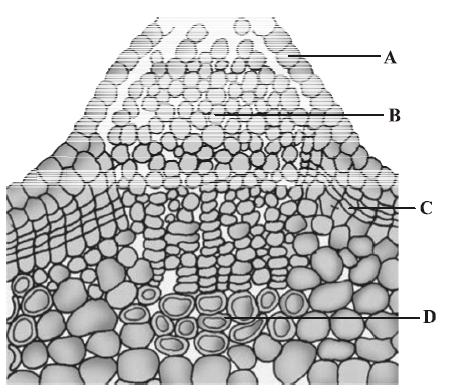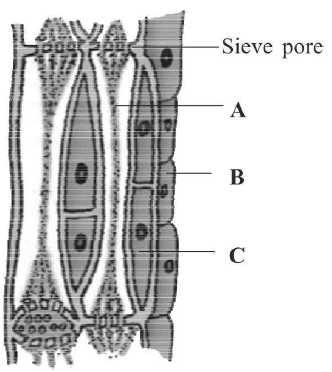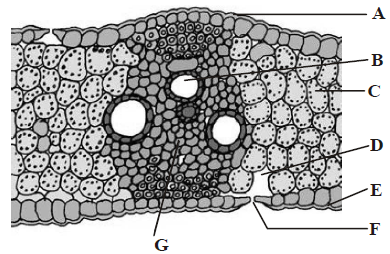Which of the following statement(s) is/are correct ?
- Uneven thickening of cell wall is characteristic of sclerenchyma.
- Periblem forms cortex of the stem and the root.
- Tracheids are the chief water transporting elements in gymnosperms.
- Companion cell is devoid of nucleus at maturity.
- The commercial cork is obtained from Quercus suber.
(i) and (iv) only
(ii) and (v) only
(iii) and (iv) only
(ii), (iii) and (v) only
Correct Answer :
D. (ii), (iii) and (v) only
Statements (ii), (iii) and (v) are correct. (i) Uneven thickening of the cell wall is not the characteristics of sclerenchyma. (iv) A mature sieve elements are devoid of nucleus at maturity.
Related Questions
Match column-I with column-II and choose the correct option.
| A. Spring wood or | I. Lighter in colour early wood |
|---|---|
| B. Autumn wood or | II. High density late wood |
| .. | III. Low density |
| .. | IV. Darker in colour |
| .. | V. Larger number of xylem elements |
| .. | VI. Vessels with wider cavity |
| .. | VII. Lesser number of xylem elements |
| .. | VIII. Vessels with small cavity |
Which of the following combination is correct ?
A II, IV, VII, VIII; B I, III, V, VI
A I, II, VII, VIII; B III, IV, V, VI
A I, III, V, VI; B II, IV, VII, VIII
A I, III, VII, VIII; B II, IV, V, VI
Which of the following process helps the trichomes in preventing water loss?
Where companion cells helps in maintaining the pressure gradient in the sieve tubes.
Where plants absorb water through the roots and then give off water vapor through pores in their leaves.
Where activity of cork cambium builds pressure on the remaining layers peripheral to phellogen and ultimately these layers dies and slough off.
None of the above
One of the primary function of the ground tissue in a plant is
photosynthesis.
to protect the plant.
to anchor the plant.
water and sugar conduction.
Lignin is the important constituent in the cell wall of
phloem
parenchyma
xylem
cambium
Read the following statements and answer the question.
- Cambium is very active and produces a large number of xylary elements having vessels with wider cavities.
- It is also called early wood.
- It is lighter in colour and has lower density.
Which type of wood is described by the above statements?
Sap wood
Heart wood
Spring wood
Autumn wood
The __________ occurs in layers below the epidermis in dicotyledonous plants.
parenchyma
sclerenchyma
collenchyma
aerenchyma
Match the followings and choose the correct option
| Column-I | Column-II |
|---|---|
| A. Cuticle | I. Guard cells |
| B. Bulliform cells | II. Outer layer |
| C. Stomata | III. Waxy layer |
| D. Epidermis | IV. Empty colourless cell |
A III, B IV, C I, D II
A I, B II, C III, D IV
A III, B II, C IV, D I
A III, B II, C I, D IV
Which of the following pair of match is not correct?
Pith - Large and well developed in monocotyledonous root.
Root hairs - Helps in preventing water loss due to transpiration
Sieve tube elements - Its functions are controlled by the nucleus of companion cells.
Stomatal apparatus - Consists of stomatal aperture, guard cells and surrounding subsidiary cells
Which one of the followings option shows the correct labelling of the parts marked as A, B, C and D in the given figure a lenticel?

A Epidermis, B Secondary cortex, C Cork cambium, D Cork
A Pore, B Cork cambium, C Secondary cortex, D Cork
A Pore, B Cork, C Complimentary cells, D Cork cambium
A Epidermis, B Complimentary cells, C Cork cambium, D Secondary cortex
In the given figure of phloem tissue, identify the marked part (A, B and C) which help in maintaining the pressure gradient
in the sieve tubes.

A
B
C
None of the above
Read the following statements and answer the question.
- It has a sclerenchymatous hypodermis, a large number of scattered vascular bundles and a large parenchymatous ground tissue.
- Vascular bundles are conjoint and closed.
- Peripheral vascular bundles are generally smaller than the centrally located ones.
- Phloem parenchyma is absent, and water- containing cavities are present within the vascular bundles.
Which plant anatomy is being described by the above statements?
Dicotyledonous root
Monocotyledonous root
Dicotyledonous stem
Monocotyledonous stem
A plant tissue when stained showed the presence of hemicellulose and pectin in cells wall of its cells. The tissue is called
collenchyma
sclerenchyma
xylem
meristem
T.S. of dicot leaf passing through the midrib is given below. Certain parts have been marked by alphabets (A to H). Choose the option showing their correct labelling.

A Epidermis, B Spongy mesophyll, C Palisade mesophyll, D Stomata, E Guard cells, F Phloem, G Metaxylem, H Protoxylem
A Epidermis, B Palisade mesophyll, C Spongy mesophyll, D Sub-stomatal cavity, E Stoma, F Phloem, G Xylem, H Bundle sheath
A Epidermis, B Palisade mesophyll, C Spongy mesophyll, D Stomata, E Guard cells, F Epidermis, G Xylem, H Phloem
A Epidermis, C Palisade mesophyll, C Spongy mesophyll, D Stomata, E Guard cells, F Phloem, G Metaxylem, H Protoxylem
Choose the correct labelling of (A J) in the given figure of T.S. of monocot root.

A Root hair, B Epiblema, C Cortex, D Endodermis, E Passage cell, F Pericycle, G Pith, H Phloem, I Metaxylem.
A Root hair, B Epiblema, C Cortex, D Endodermis, E Passage cell, F Pith, G Pericycle, H Metaxylem, I Phloem.
A Root hair, B Epiblema, C Cortex, D Endodermis, E Pericycle, F Phloem, G Protoxylem, I Metaxylem
A Root hair, B Cortex, C Epiblema, D Pericycle, E Endodermis, F Pith, G Phloem, H Protoxylem, I Metaxylem
Which of the following are present in monocot root ?
conjoint, collateral, open polyarch vascular bundle.
exodermis, endarch, tetrarch closed vascular bundles.
suberized exodermis, casparian strip, passage cells, cambium.
suberized exodermis, polyarch xylem, pith.
Sieve tubes are suited for translocation of food because they possess
bordered pits.
no ends walls.
broader lumen and perforated cross walls.
no protoplasm.
A narrow layer of thin walled cells found between phloem/ bark and wood of a dicot is
cork cambium
vascular cambium
endodermis
both (a) & (c)
The given diagrams show stomatal apparatus in dicots and monocots. Which one is correct option for A, B and C?

A Epidermal cells; B Subsidiary cells; C chloroplast
A Guard cells; B Subsidiary cells; C Stomatal pore
A Guard cells; B Epidermal cells; C Guard cells
A Epidermal cells; B Subsidiary cells; C Guard cells
Various functions like photosynthesis, storage, excretion performed by _____________.
sclerenchyma
parenchyma
collenchyma
aerenchyma
Main function of lenticel is
transpiration
guttation
gaseous exchange
both (a) & (c)
Bast fibres are made up of _____________cells.
sclerenchymatous
chlorenchymatous
parenchymatous
aerenchymatous
Match the names of the structures given in column-I with the functions given in column-II, choose the answer which gives the correct combination of the two columns :
| Column-I | Column-II |
|---|---|
| (Structure) | (Function) |
| A. Stomata | I. Protection of stem |
| B. Bark | II. Plant movement |
| C. Cambium | III. Secondary growth |
| D. Cuticle | IV. Transpiration |
| V. Prevent the loss of water | ... |
A V, B III, C I, D IV
A I, B IV, C V, D III
A II, B IV, C I, D III
A IV, B I, C III, D V
Which one of the following have vessels as their characteristic feature?
Angiosperms
Gymnosperms
Pteridophytes
Bryophytes
An organised and differentiated cellular structure having cytoplasm but no nucleus is called _________.
vessels
xylem parenchyma
sieve tubes
tracheids
Gymnosperms are also called soft wood spermatophytes because they lack
cambium
phloem fibres
thick-walled tracheids
xylem fibres
Cork cambium and vascular cambium are
the parts of secondary xylem and phloem.
the parts of pericycle.
lateral meristems.
apical meristems.
A common structural feature of vessel elements and sieve tube elements are
pores on lateral walls.
presence of p-protein.
enucleate condition.
thick secondary walls.
In stems, the protoxylem lies towards the _____________ and the metaxylem lies towards the ____________ of the organ.
centre; periphery
periphery; centre
periphery; periphery
centre; centre
T.S. of monocot leaf is given below, certain parts have been marked by alphabets (A G). Which one is the option showing there correct labelling?

A Adaxial epidermis, B Xylem, C Mesophyll, D Sub-stomatal cavity, E Abaxial epidermis, F Stoma, G Phloem
A Adaxial epidermis, B Abaxial epidermis, C Xylem, D Sub-stomatal cavity, E Stoma, F Mesophyll, G Phloem
A Adaxial epidermis, B Phloem, C Mesophyll, D Sub-stomatal cavity, E Abaxial epidermis, F Xylem, G Stoma
A Adaxial epidermis, B Xylem, C Stoma, D Substomatal cavity, E Abaxial epidermis, F Phloem, G Mesophyll
Match column-I with column-II and select the correct option from the codes given below.
| Column-I | Column-II |
|---|---|
| A. Stele | I. Innermost layer of cortex |
| B. Endodermis | II. Suberin |
| C. Casparian strips | III. All the tissues exterior to vascular cambium |
| D. Bark | IV. All the tissues inner to endodermis |
A IV, B I, C II, D III
A III, B II, C I, D IV
A I, B II, C III, D IV
A IV, B II, C I, D III
